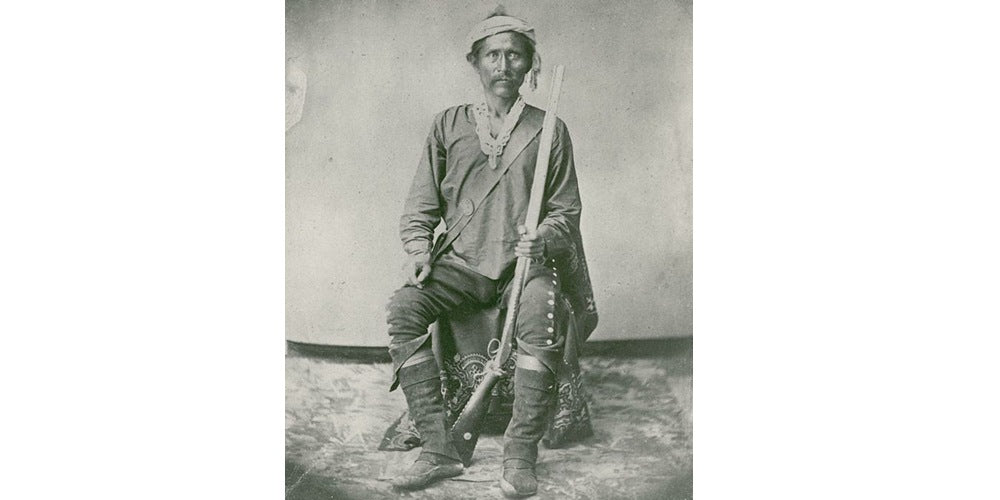
There have been many notable Native Americans in history, and among those most famous Navajo were Chiefs Barboncito and Manuelito.
Barboncito was a highly respected Navajo (Dine) spiritual and political leader. Born around 1820 into the Coyote Pass People clan of Canyon de Chelly in Arizona, he was intrinsic to the return of the Navajo to their ancestral lands in the late 1860s.
The name “Barboncito” translates from Spanish “little bearded one”. His Dine name was Hastiin Dagha (“Man with Whiskers”), as well as other names that translated as “The Orator” and “Blessing Speaker”. He chose to, as much as possible, not participate in conflicts between the Navajo and Europeans.
In 1846, he was a signatory of the Doniphan Treaty which sought to establish peace between the Navajo and Europeans during the Mexican War. It was ultimately unsuccessful. During the 1850s he was a mediator between Navajo and the white Americans, proposing peace, but was not successful as fights ultimately broke out between the groups over the Navajo grazing lands near Fort Defiance in eastern Arizona.
The Navajo lands were being raided by the US army, Mexicans, Zuni, and Ute tribes. After the slaughter of Navajo horses by the whites, Barboncito, working alongside Chief Manuelito, led an armed rebellion of 1000 Navajo warriors on Fort Defiance in Arizona in 1860; the Navajo very nearly succeeded and a short term treaty was achieved. Following a crushing retaliation by the US Army in 1863, however, Barboncito actively encouraged a more peaceful approach from his people.
He was captured and imprisoned in 1864, escaping in mid-1865. Thousands of Navajo people had been imprisoned by the American government at New Mexico’s Bosque Redondo Reserve, in the far east of the state, during the 1860s. Bosque Redondo was an exceedingly difficult place for the Navajo to thrive, due to poor soil and water quality, a lack of firewood, and attacks by rival Native American tribes. As a people, the Navajo struggled to survive.
In the late 1860s, General Sherman offered the Navajo leaders, including Barboncito, land for a reservation in Kansas. They declined this and held out for their ancestral lands on which they had historically thrived. As a leading Navajo negotiator, Barboncito travelled to Washington DC, where he was given more authority by the US government than tribal law would have customarily accorded him. He personally met with General Sherman and facilitated the Treaty that ultimately established the Navajo Reservation in its present location and within those ancestral lands. It was known as the Bosque Redondo Treaty of 1868. This meeting and treaty also ended hostilities between the US government and the Navajo. The impact was instrumental in the ultimate success of the Navajo Nation, its culture, and its relationships with non-Navajo people.
Barboncito died in his home in Canyon de Chelly in 1871 and, according to reports, he was buried with a handwritten copy of the Treaty he brought about.

Manuelito was a Navajo war chief, born in Utah near Bear Ears Peak in 1818. A member of the Folded Arms People clan, his father Cayetano was renowned for his strong resistance to any form of foreign invasion.
As a young man, Manuelio (Spanish for “little Manuel”) migrated to Arizona, joining the band of Chief Narbona and marrying his daughter (the first of his four wives). Despite his father-in-law’s fearlessness and commitment to the value of peace as well as war, Manuelito, a tall and imposing man, strove to become a warrior.
Manuelito’s first battle was at Narbona Pass in 1835, where he fought against 1000 Mexicans who were attacking the Navajo. His Navajo name thereafter, Hashkeh Naabaah, translates to “Angry Warrior”. Manuelito led many raids, sometimes joining Barboncito and other leaders, and attacking everyone from Mexicans to Hopi, Ute, Comanche, Apache, and Pueblo Indians.
He signed the Bear Springs Treaty in 1846, and eight others thereafter, to varying levels of success.
When the Navajo Long Walk to the Bosque Redondo Reservation began, Manuelito and many other Navajo fled into the western New Mexico mountains. From there, they waged guerilla warfare but were forced to surrender in late 1866 due to starvation. At Bosque Redondo, Manuelito encouraged his people and petitioned the government for a return to the Navajo homelands. Alongside Barboncito and other leaders, Manuelito went to Washington DC in 1868 to plead their case for the new reservation on traditional Navajo homelands.
Upon return to his home, Manuelito became head of the tribal police and was a tireless advocate for the education of the Navajo people. He died in 1893 from complications of measles.
Today, the Navajo (Dine) Nation thrives and is the largest Native American reservation in the USA.
Indian Traders is very proud to showcase and support Navajo artisanship and local communities by selling original, genuine handcrafted Native American turquoise jewelry and other jewelry items made by Navajo silversmiths and beaders, including Harrison Bitsue, Danny Martinez, Leon Martinez, Eva and Lindberg Bilah, Carol Tsinnie, Bruce Morgan, Leandro Tahe, and several others. Browse our full range of Hopi jewelry now.
